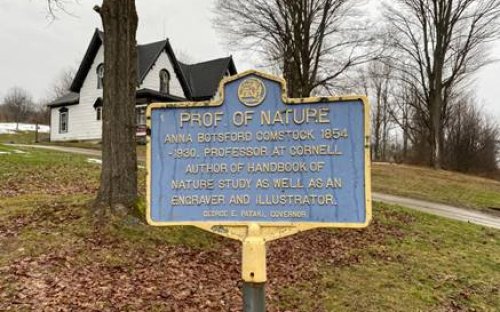Anna Botsford Comstock, born Anna Botsford on September 1, 1854, was early contributor to, and leader of, the Nature Study Movement. The Nature Study Movement was a push toward encouraging outdoor, first-hand observation and study of plants, animals, insects, etc. rather than through just reading books. Anna was born in Otto, NY in Cattaraugus County. Anna’s early years were spent observing the natural world with her mother around the family farm. Her mother taught her the names of flowers, plants, constellations, and more. Anna’s mother’s passion for nature led to Anna’s love and appreciation of it as well.
Anna knew from an early age that she wanted to receive a university education. She decided on Cornell University after being told by a friend that the “boys won’t pay any attention to the college girls.” Her response was that “Cornell must be a good place for a girl to get an education; it has all the advantages of a university and a convent combined.” Anna started studies at Cornell in late 1874, and attended two years’ worth of classes. There she met her future husband, John Henry Comstock, a professor of entomology. They married in 1878.
Despite no formal training in illustration or drawing, Anna began illustrating her husband’s entomology books by observing the insects under a microscope and copying what she saw. She found she had a great skill for it. Additionally, she taught herself wood engraving for purposes of illustrating her husband’s books. She became extremely accomplished in wood engraving after further studying the subject at Cooper Union and was made a member of the Society of American Wood Engravers, only the third woman ever to receive such honor. She went on to engrave numerous original plates for her husband’s and her own publications on various nature studies, and has been recognized for her skill and attention to detail.
Anna returned to Cornell and completed her Bachelor of Science degree in 1885. She continued her research and illustration work with her husband while she completed her studies. She was inducted into Sigma Xi, the honorary society for scientists and engineers, as one of the first women to be inducted in 1888. In 1898, she was appointed as the first female professor at Cornell University as assistant professor teaching Nature Study. One of her goals was to instruct rural teachers in the methods of Nature Study so those teachers could then go out and cultivate the interest of rural children in nature. The theory was that encouraging rural children’s interest in the nature around their farms would lead to better farming practices and prevent further agricultural depression in rural areas. She was made a full professor at Cornell University in 1919 and retired in 1922. In 1923, Anna was named as one of the twelve greatest women in America by the League of Women Voters, as she had been the most influential person in her field of study.
Anna Botsford Comstock died in 1930. One of her most famous publications, The Handbook of Nature Study, is still in print today and has been translated into eight languages. She was inducted into the National Wildlife Federation Conservation Hall of Fame in 1988, in recognition of her role as the “mother” of nature studies.
Written by: Shannon C. McGlew
Sources Beal, W. J., et al. “What Is Nature Study?” Science, vol. 16, no. 414, 1902, pp. 910–913. JSTOR, www.jstor.org/stable/1628587. Comstock, Anna Botsford. The Comstocks of Cornell: John Henry Comstock and Anna Botsford Comstock. Edited by Glenn W. Herrick and Ruby Green Smith, Cornell University Press, 1953. JSTOR, www.jstor.org/stable/10.7591/j.ctvn1tb4h. “Conservation Hall of Fame.” National Wildlife Federation, https://www.nwf.org/AboutUs/History/Conservation-Hall-of-Fame. D’Acunto, Samantha, “Anna Botsford Comstock: Trailblazer in Nature Education.” New York Botanical Garden, June 16, 2017, https://www.nybg.org/blogs/plant-talk/2017/06/from-thelibrary/anna-botsf...

